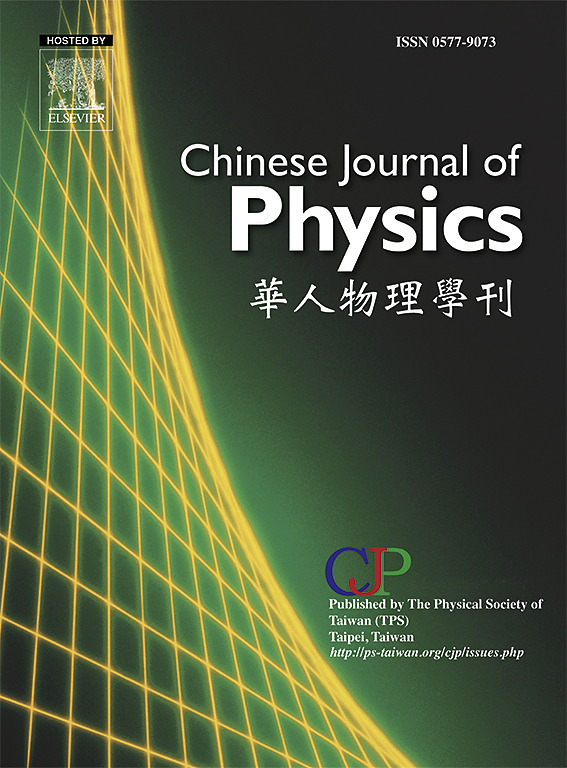Stagnation slip flow of ternary hybrid nanofluid over an exponentially shrinking/Stretching sheet with joule heating, MHD, and thermal radiation effects
IF 4.6
2区 物理与天体物理
Q1 PHYSICS, MULTIDISCIPLINARY
引用次数: 0
Abstract
The stagnation point flow of a ternary hybrid nanofluid (THNF) over a sheet that stretches or shrinks exponentially is investigated in this study. The primary goal is to assess the implication of Joule heating, magnetohydrodynamics (MHD), thermal radiation, and boundary slips on the physical quantities and flow profiles. Besides, attention is also given to the occurrences of multiple solutions in this fluid flow situation. The continuity, momentum and energy equations that described the fluid flow problem are converted into a simpler form of ordinary differential equations (ODEs). This is achieved by applying a similarity transformation, which make the equations easier to solve. Solving the resulting equations using the bvp4c solver in MATLAB software yields results that are analyzed and illustrated through a combination of tables and graphical representations. The analysis reveals that, for a shrinking sheet, an increase in Joule heating reduces the heat transfer. Similarly, a higher thermal slip factor leads to a decreased heat transfer rate in this case. In contrast, parameters such as magnetic field strength, radiation, velocity slip and suction contribute to enhancing the heat transfer rate of THNF. Furthermore, the results indicate that the THNF used in this study exhibits a better heat transfer rate compared to nanofluid (NF) and hybrid nanofluid (HNF). Notably, a shrinking sheet is observed to exhibit multiple solutions when the shrinking parameter falls within a defined range, specifically when . By scrutinizing the analysis of stability, the first solution (upper solution) was determined to be consistently stable and applicable in real-world settings. These findings offer insightful information into the optimization of heat transfer processes in nanofluid-based systems under complex flow conditions. However, these findings apply only to a THNF mixture of alumina, copper, and titania. THNFs may have different flow dynamics and thermal properties depending on the mixtures of nanoparticles.

具有焦耳加热、MHD和热辐射效应的三元杂化纳米流体在指数收缩/拉伸薄片上的滞滑流动
本文研究了三元杂化纳米流体(THNF)在指数拉伸或收缩薄片上的滞止点流动。主要目的是评估焦耳加热、磁流体动力学(MHD)、热辐射和边界滑移对物理量和流动剖面的影响。此外,还注意了在这种流体流动情况下多重解的出现。描述流体流动问题的连续性、动量和能量方程被转换成一种更简单的常微分方程(ode)形式。这是通过应用相似变换实现的,这使得方程更容易求解。在MATLAB软件中使用bvp4c求解器求解得到的方程,结果通过表格和图形表示的组合进行分析和说明。分析表明,对于收缩板材,焦耳加热的增加会减少传热。同样,在这种情况下,较高的热滑移系数导致传热速率降低。相反,磁场强度、辐射、速度滑移和吸力等参数对THNF的换热率有促进作用。此外,研究结果表明,与纳米流体(NF)和混合纳米流体(HNF)相比,本研究中使用的THNF具有更好的传热速率。值得注意的是,当收缩参数落在规定的范围内时,特别是当λ>;λc时,观察到收缩片呈现多重解。通过仔细分析稳定性,确定了第一个解决方案(上面的解决方案)始终稳定,并适用于实际环境。这些发现为复杂流动条件下纳米流体系统的传热过程优化提供了有见地的信息。然而,这些发现只适用于氧化铝、铜和二氧化钛的THNF混合物。纳米颗粒的混合物可能具有不同的流动动力学和热性能。
本文章由计算机程序翻译,如有差异,请以英文原文为准。
求助全文
约1分钟内获得全文
求助全文
来源期刊

Chinese Journal of Physics
物理-物理:综合
CiteScore
8.50
自引率
10.00%
发文量
361
审稿时长
44 days
期刊介绍:
The Chinese Journal of Physics publishes important advances in various branches in physics, including statistical and biophysical physics, condensed matter physics, atomic/molecular physics, optics, particle physics and nuclear physics.
The editors welcome manuscripts on:
-General Physics: Statistical and Quantum Mechanics, etc.-
Gravitation and Astrophysics-
Elementary Particles and Fields-
Nuclear Physics-
Atomic, Molecular, and Optical Physics-
Quantum Information and Quantum Computation-
Fluid Dynamics, Nonlinear Dynamics, Chaos, and Complex Networks-
Plasma and Beam Physics-
Condensed Matter: Structure, etc.-
Condensed Matter: Electronic Properties, etc.-
Polymer, Soft Matter, Biological, and Interdisciplinary Physics.
CJP publishes regular research papers, feature articles and review papers.
 求助内容:
求助内容: 应助结果提醒方式:
应助结果提醒方式:


